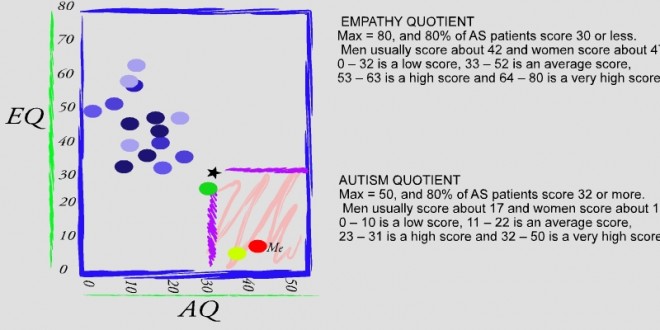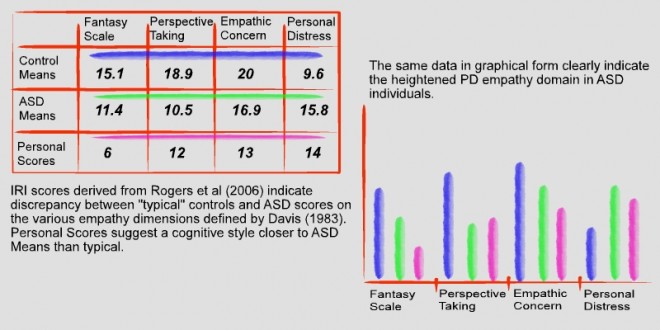Empathy has been the subject of much discussion throughout the course of this research. Empathy is "the fundamental people skill", the key to emotional intelligence (Goleman, 1996, p. 43) and the "root of morality" (Hoffman, 1991, p. 276). It is a primary element in the development and application of social ability. It is a term that comes up regularly in the literature on autoethnography - a writer should encourage compassion and empathy (Ellis, 1999; Holt, 2003) in the reader. My supervisors and research teachers advise students to empathise with audience and assessors when considering what and how to write. It is a highly desirable skill in teaching and management, and musicians speak openly about empathising with each other and with the music itself when playing. The apparent ability of music to evoke emotional response in listeners is also described using the term. While the term is not specifically used in either the Gillberg (1989) or DSM-iv (1994) criteria for ASDs, almost all descriptions of the condition indicate that lack of, or impairment in empathy is a primary indicator for Asperger's Syndrome. An examination of empathy is of critical importance to my own life, as a musician, a composer for theatre and film, a collaborator in studios, a teacher, spouse, parent and member of society.
In 2004 a self-administered test was developed at Cambridge University's Autism Research Centre to measure empathy in the high functioning autistic population. The Empathy Quotient (EQ) (Baron-Cohen & Wheelwright, 2004) along with the Autism Quotient (AQ) (Baron-Cohen, Wheelright, Martin, Skinner, & Clubley, 2001) and Systematising Quotients (SQ) (Baron-Cohen, Richler, Bisarya, Gurunathan, & Wheelwright, 2003) have been widely used as screening tools worldwide and adapted for various population groups, such as Japanese (Wakabayashi, Tojo, Baron-Cohen, & Wheelwright, 2004), adolescents (Baron-Cohen, Hoekstra, Knickmeyer, & Wheelwright, 2006) and others and found to have a strong interdependent predictability (Wheelwright et al., 2006).
During the planning of this research, ethical clearance was obtained to use these tools to test large numbers of students and colleagues at my Conservatorium to establish some baseline population figures for autistic traits and empathy within a musical community. While the large scale testing was abandoned in favour of the more personalised approach of autoethnography, the ethical clearance allowed me to collect data from individuals with whom I was collaborating and working. The results of this testing is indicated in graphical form below. The dots indicate the results for various collaborators, roughly evenly divided by gender and aged between 18 and 60. The numerical data is available in the appendix. Although the sample size is small, it is clear that the majority of individuals fall within the average to high scores for empathy and the average to low scores for autistic traits. The red dot with scores of 37 for autistic traits and 9 for empathy, represents my own results. The yellow dot is my former student "Allan" who has a diagnosis of Asperger's Syndrome. Both of us are strongly aware of difficulties in "getting" people. The individual with the green spot, is described by peers as "dry", "really smart but a bit aloof" and "a wealth of knowledge if you can get him to share". While by no means a large sample from a statistical perspective, the real world significance of this data set is clear. These are the people I work with, and the difference in cognitive traits and empathy is made apparent.
Data such as this collected both from diagnosed individuals and their families, along with controls with no familial history of autism is gradually establishing a set of observable characteristics or an "autistic phenotype" (Bishop, Maybery, Wong, Maley, & Hallmayer, 2006; Clifford et al., 2007; Newschaffer et al., 2007; Piana, Fortin, Noulhiane, Golse, & Robel, 2007; Scheeren & Stauder, 2007; Scheeren & Stauder, 2008; Skuse, Mandy, & Scourfield, 2005). In addition, better indicators of both the depth and variance of the autistic spectrum and the range of autistic characteristics extant within the general population are increasingly coming to light.
The method of evaluating empathy with the EQ tool has been applied to a variety of population groups and referenced for reliability (Berthoz, Wessa, Kedia, Wicker, & Grezes, 2008; Carroll & Chiew, 2006; Hambrook, Tchanturia, Schmidt, Russell, & Treasure, 2008; Killgore et al., 2007; Lawrence, Shaw, Baker, Baron-Cohen, & David, 2004) however recent criticisms have focussed on its measure of empathy as a single construct. Rogers (2006) draws on the work of Mark Davis (1980; 1983) to address empathy as existing in more than one dimension. Davis found that "Cognitive empathy refers to the intellectual capacity of an observer to imagine the psychological point of view of another; it does not necessarily imply any emotional reaction on the part of the observer. Emotional (affective) empathy, on the other hand, refers specifically to the experiencing of some emotional reaction as a result of observing another'' (Davis, 1983, p. 223). Cognitive empathy is closely related to Theory of Mind (Rogers et al., 2006) but emotional empathy appears to be an independent issue and the description "deficits in empathy" may not be strictly accurate or useful element in diagnosing autism.
Empathy as measured by the EQ is clearly indicated as impaired in studies of Asperger's Syndrome, however the tool is largely targeting the cognitive domain (Dziobek et al., 2008; Rogers et al., 2006). Rogers' study used Davis' Interpersonal Reactivity Index (IRI) to indicate that while COGNITIVE empathy is certainly in deficit, AFFECTIVE empathy tends to be at least as strong in AS individuals as in controls. This would suggest that once the AS person can correctly identify the emotive content of a given situation, they may experience a stronger than "average" feeling of personal distress in response to suffering of others although they may not recognise it, and are capable of responding in a caring and compassionate manner. In musical context, this suggestion would indicate that defining an emotional context via cognitive means can help to illicit an appropriate emotional or musical response in the AS individual.
Davis's IRI test address four dimensions of empathy, beginning with two cognitive aspects.
The Fantasy Scale (FS)... appears to tap the tendency to imaginatively transpose oneself into fictional situations (e.g., books, movies, daydreams).
The second subscale, the Perspective-Taking Scale (PT), reflects a proclivity to shift perspectives and adopt the point of view of others - when dealing with other people in everyday situations. It is associated with skilful social style and good self esteem.
The other two subscales explicitly deal with emotional responses to observed emotionality in others. The first of these, the Empathic1 Concern Scale (EC), assesses feelings of warmth, compassion and concern for unfortunate others. This dimension seems closest to the common understanding of the term sympathy and is associated with altruistic behaviour. The Personal Distress Scale (PD), on the other hand, is self-oriented, and measures the individual's own feelings of fear, apprehension and discomfort at witnessing the negative experiences of others (Davis, 1983).
The table below sets out my own results from Davis Interpersonal Interactivity Index, set against data from Rogers (2006) . The control means is indicated in blue, the ASD means in green, and my own results in red. It shows a pattern that is predictable from Rogers' findings, specifically that cognitive elements are lower than control means and that personal distress is somewhat higher. It is useful to bear these figures in mind while considering the workings of empathy in my musical, professional and social life.
The subject of empathy, and my own lack of it in musical and other social situations, is raised in many places through the dissertation, and this page is referred to on numerous occasions. These tests are a clear indication that my empathic responses are qualitatively different.
- I have followed Davis' lead in the use of empathic as the adjectival form. Empathetic just seems to be too much the pun [?]
Related Posts
- I'm alright ...: Asperger's can be quite successfully "hidden" from the world at large through the development of coping strategies. There is a cost however...
- Surveys: The Cambridge Personality Index surveys - AQ and EQ
- Alexithymia: Alexithymia literally means "no words for the feelings". It describes a difficulty in recognising and expressing one's own emotions.
- The method - overview: An overview of the methodology including a short animation explaining the major methods employed and their relationships.
- The Heart of the Brain: The internal brain structures and pathways appear to have an impact on several aspects of autism, including executive function, the over-riding regulatory mechanisms for cognition and behaviour.
- Psychological stress: Asking people to observe and report on their cognitive selves can pose ethical dilemmas
- Statistics: Information on prevalence and distribution of ASD in the community.

